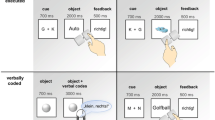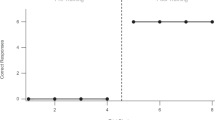Abstract
Joint stimulus control occurs when responding is determined by the correspondence of elements of a complex sample and a complex comparison stimulus. In academic settings, joint stimulus control of behavior would be evidenced by the selection of an accurate description of a complex graph in which each element of a graph corresponded to particular sentences and phrases in the description. The current research describes a test that detected various degrees of joint stimulus control by different combinations of elements, ranging from complete joint control by all elements to a lack of joint control by any elements.
Similar content being viewed by others
References
ALONSO-ALVAREZ, B., & PEREZ-GONZALEZ, L. A. (2006). Emergence of complex conditional discriminations by joint control of compound samples. The Psychological Record, 56, 447–463.
CARPENTIER, F., SMEETS, P. M., & BARNES-HOLMES, D. (2000). Matching compound samples with unitary comparisons: Derived stimulus relations In adults and children. The Psychological Record, 50, 671–685.
CRITCHFIELD, T. S., & PERONE, M. (1993). Verbal self-reports about matching to sample: Effects of the number of elements In a compound sample stimulus. Journal of the Experimental Analysis of Behavior, 59, 193–214. doi:10.1901/jeab.1993.59-193
EMURIAN, H. H., & WEISS, S. J. (1972). Compounding discriminative stimuli controlling free-operant avoidance. Journal of the Experimental Analysis of Behavior, 17, 249–256. doi:10.1901/jeab.1972.17-249
FIELDS, L., TRAVIS, R., ROY, D., YADLOVKER, E., DE AGUIAR-ROCHA, L., & STURMEY, P. (2009). Equivalence class formation: A method for teaching statistical interactions. Journal of Applied Behavior Analysis, 42, 575–593.
FIENUP, D., COVEY, D., & CRITCHFIELD, T. (2010). Teaching brain-behavior relations economically with stimulus equivalence technology. Journal of Applied Behavior Analysis, 43, 19–33.
GOLDSTEIN, H. (1983). Recombinative generalization: Relationships between environmental conditions and the linguistic repertoires of language learners. Analysis and Intervention In Developmental Disabilities, 3, 279–293. doi:1016/0270-4684(83)90002-2
GOLDSTEIN, H. (1985). Enhancing language generalization using matrix and stimulus equivalence training. In S. Warren & A. K. Rogers-Warren (Eds.), Teaching functional language: Generalization and maintenance of language skills (pp. 225–249). Baltimore, MD: University Park Press.
GOLDSTEIN, H., & MOUSETIS, L. (1989). Generalized language learning by children with severe mental retardation: Effects of peers’ expressive modeling. Journal of Applied Behavior Analysis, 22, 245–259. doi:10.19O1/jaba.1989.22-245
JOHNSON, D. F., & CUMMING, W. W. (1968). Some determiners of attention. Journal of the Experimental Analysis of Behavior, 11, 157–166. doi:10.1901/jeab.1968.11-157
KAMIN, L. J. (1968). “Attention-like” processes In classical conditioning. In M. R. Jones (Ed.), Miami symposium on the prediction of behavior: Aversive stimulation (pp. 9–31). Miami: University of Miami.
LOWENKRON, B. (1998). Some logical functions of joint control. Journal of the Experimental Analysis of Behavior, 69, 327–354. doi:10.1901/jeab.1998.69-327
LOWENKRON, B. (2006). An introduction to joint control. The Analysis of Verbal Behavior, 22, 123–127.
MARKHAM, M. R., & DOUGHER, M. J. (1993). Compound stimuli In emergent stimulus relations: Extending the scope of stimulus equivalence. Journal of the Experimental Analysis of Behavior, 60, 529–542. doi:10.1901/jeab.1993.60-529
REYNOLDS, G. (1961). Attention In the pigeon. Journal of the Experimental Analysis of Behavior, 4, 203–208. doi:10.1901/jeab.1961.4-203
STROMER, R., MCILVANE, W. J., DUBE, W. V., & MACKAY, H. A. (1993). Assessing control by elements of complex stimuli In delayed matching to sample. Journal of the Experimental Analysis of Behavior, 59, 83–102. doi:10.1901/jeab.1993.59-83
Author information
Authors and Affiliations
Corresponding author
Additional information
This research was conducted with support from PSC-CUNY Research Award 61669–00–39 and CUNY Collaborative Research Grant 80209–09–13.
Rights and permissions
About this article
Cite this article
Fields, L., Spear, J. Measuring Joint Stimulus Control by Complex Graph/Description Correspondences. Psychol Rec 62, 279–293 (2012). https://doi.org/10.1007/BF03395802
Published:
Issue Date:
DOI: https://doi.org/10.1007/BF03395802




